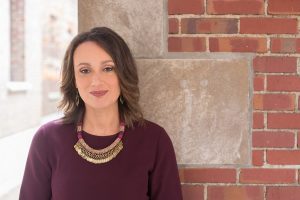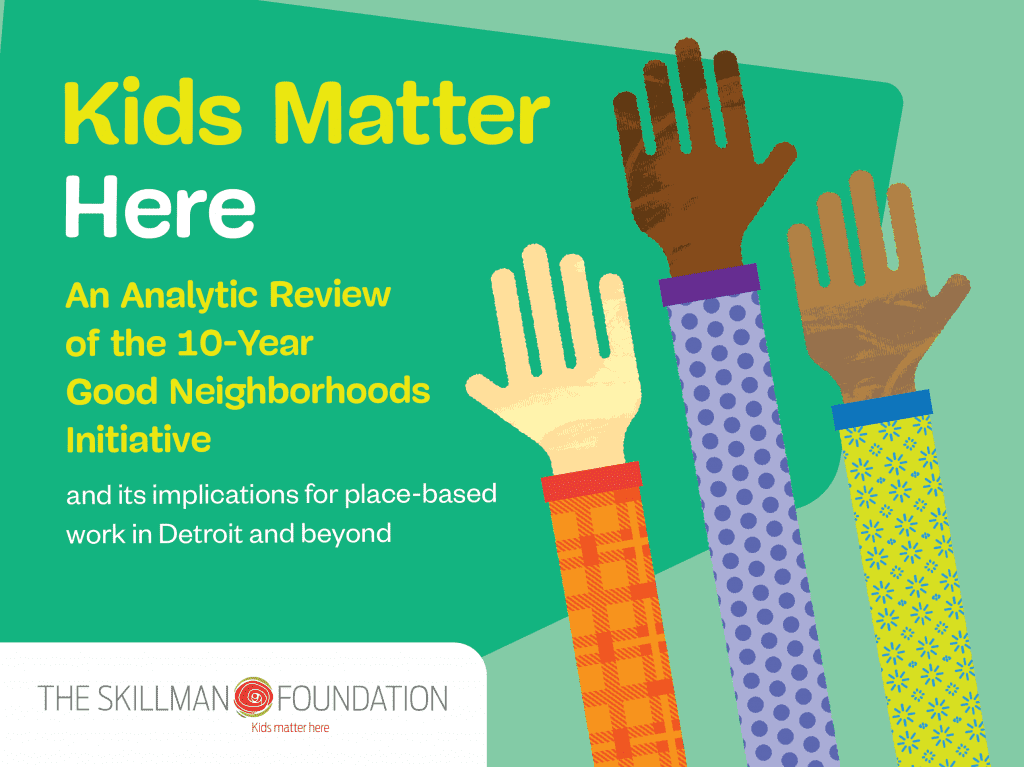
College and Career Pathways, K-12 Education
Reviewing the Good Neighborhoods Initiative
 Detroit is my hometown. It is where I have grown and matured. It is where I have learned about community and conflict, resiliency and bleakness, and grandeur and disinvestment. Detroit is a place filled with contradiction. Where some hit cement ceilings and others propel to great heights. Where some dream of escape and others dig in for the long-haul. It is a place where people love hard and can bear an inordinate amount of pain.
Detroit is my hometown. It is where I have grown and matured. It is where I have learned about community and conflict, resiliency and bleakness, and grandeur and disinvestment. Detroit is a place filled with contradiction. Where some hit cement ceilings and others propel to great heights. Where some dream of escape and others dig in for the long-haul. It is a place where people love hard and can bear an inordinate amount of pain.
I am a long-hauler; one of those Detroiters who has a deep and stubborn love for my city, and a determinedness to see its people thrive.
This determination stems from my grandmother, a neighborhood organizer and activist, whose work, rooted in the gospel, came with great sacrifice and scrutiny. Her example gifted me purpose.
During my childhood, we uprooted and resettled in a spread of Detroit neighborhoods as my mother scrambled to provide for our family. She provided me a sense of stability as we endured the economic volatility and social regression happening in Detroit. Through my mother, I learned persistence, hard work and love.
As a young professional, I was able to put these values and skills to work as the director of Annie E. Casey Foundation’s Rebuilding Communities Initiative in Detroit, one of the first comprehensive community initiatives in our country. This work was exciting and powerful. It revealed to me that I wasn’t alone. There were thousands of stubborn, long-haul Detroiters willing to work together to restore our communities.
Leading the Skillman Foundation’s Good Neighborhoods Initiatives over the past decade, coupled with these experiences, constitutes much of my personal and professional life. It is in this verity that I can declare I have grown up in this work. It has matured me, shaped me and defined me. It’s in my DNA. This work isn’t just a profession, it’s a personal calling.
Now, as the neighborhood initiative concludes, I think about the growth that’s taken place within our city, our neighborhoods, our Foundation, and within me. Reflecting on this journey, I’m reminded of Erik Erikson’s eight stages of psychosocial development. In each stage new challenges are confronted, resulting in the mastery of a new set of skills, strengths or virtues. Just as this is actualized in individuals, it also has been realized in through the many actors and developments in the Good Neighborhoods Initiative.
Trust & Purpose
The first stage is the development of trust in others. Establishing authentic and genuine trust is the first step in any meaningful partnership. It was particularly critical in Detroit as we entered into disinvested communities laden by unjust and racist policies. Thus, our entry began with listening tours with hundreds of residents, hearing their histories and hopes, and privileging their voices and vision. Trust required the Foundation to not only listen but also to act upon hearing. It resulted in us hiring community members, hosting community conversations, translating our work into four different languages, and investing directly in residents early and often.
Next, is the development of trust in self, under the guidance of elders. This stage was a foundational element of the Good Neighborhoods Initiative. It manifested in personal development as well as in the continuous refinements of our strategies. Both professionally and personally, I benefited from the investment, mentorship, and sponsorship of so many who generously shared their wisdom. Carol Goss, former Skillman Foundation president, a courageous and beloved mentor, grew my confidence to lead with integrity, grace, and love. Omowale Satterwhite, Garland Yates, and Prue Brown genially imparted their knowledge, earned through decades of national experience. Others offered gentle affirmations, subtle corrections and wise counsel that resulted in the work being respectful, intentional and effective.
A growing capacity was not just reserved for me. It was an intentional aspect of our strategy, shared by many actors in the Good Neighborhoods work. Nonprofit leaders and partners, neighborhood residents and activists, youth, and the Skillman Foundation team actively worked to increase our competence to work in concert with one other toward a shared vision, driven by data, and an unyielding commitment to improving outcomes for 65,000 children in six Detroit neighborhoods. This era was referred to as the Readiness Phase, which translates into initiative—the third stage in Erikson’s framework.
Competence & Fidelity
The fourth stage, competence, is developed through the challenge of learning new skills with the risk of failure. Shortly after the start of the Good Neighborhood Initiative, a series of severe changes occurred in the city. It was 2008. The market crashed and employment opportunities and housing values plummeted. Times were ominous, and I worried that our partners would be discouraged. I was swiftly liberated of this notion and reminded of Detroiters’ grit and resilience. At community meetings, people were just as engaged and energetic as before. They said, “It’s always been tough and hard. This is nothing new. It won’t stop us, it just makes us more determined.” The urgency to act, to hold things together for children, pushed us forward and constructed a competence to stay the course during one of Detroit’s harshest decades in its history.
We not only stayed the course, but we iterated often. The Skillman Foundation became a learning organization and so did our partners. We constantly assessed and asked, “Do the results of our actions match our intent?” This question regarding fidelity, the fifth stage in Erikson’s framework, drove our efforts to use and integrate data and measurements to better understand our work and to inform course adjustments. The Skillman Foundation sought to change itself first before we asked others to adopt new behaviors. So we modeled accountability to the community and to our board of trustees. We were steadfast in our commitment to the community that child well-being outcomes could improve. Thus, our fidelity was to move hard, stubborn numbers, not to be beholden to specific strategies. Additionally, difficult times and eroding conditions didn’t deter us or our board, we pressed forward with a culture of constant renewal, learning the value and necessity of being flexible and adaptive.
Love & Care
The sixth virtue is about engaging in long-term commitments and reciprocal relationships. The GNI was one of the longest and largest place-based efforts to improve children’s well-being within a single U.S. city. We exceeded our 10-year, $100-million commitment. While we carefully measured our impact along the way, we know the most powerful and lasting investments carry forward through our investment in people. These people continue to lead their neighborhoods and are now leading major efforts in our city’s transformation. They are mobilized, engaged and activated for the rest of their lives. And our city is better because of it.
This is especially true for the young people in the neighborhoods. There are numerous shining examples of youth leaders that developed during the work of the Good Neighborhoods Initiative. It has been an extraordinary privilege to see them grow, mature and take ownership of the issues affecting their neighborhoods and generation. These youth represent the Erickson’s seventh stage, guiding the next generation.
Elizabeth Morales is an outstanding example of the next generation. She became a part of the Good Neighborhoods work as a student at Cesar Chavez High School through a youth council established by Congress of Communities. Elizabeth is wicked smart and an excellent student. Her youth leadership experience helped her to cultivate a fearless voice, which she used to promote college attendance among immigrant students. Elizabeth and many of her peers relegated their postsecondary dreams to commuter schools. Through mentorship, Elizabeth transferred from a local campus to the University of Michigan. She has since graduated and starts law school in the fall of 2017. She mentored other students from her neighborhood so there was a pipeline of youth leaders following her in both the Latino and Arab-American communities.
This is how she reflects on her experience in the Good Neighborhoods: “There are little gems in Detroit that are so focused on kids. There’s a lot of money and people out there who want to see them succeed. If kids knew how many invisible hands are trying to reach out to them, they’d feel like the most special people on earth.”
Unlike Elizabeth, Stepha’N Quicksey struggled academically and entered Osborn High School with a 0.9 grade point average. College was never discussed at home, and six of his siblings had already dropped out of high school. He was mentored by teachers and caring adults, and his leadership flourished. He became the student body president for all Detroit Public Schools students. This election is a monumental achievement alone, but the honor was magnified as Stepha’N was the first student from a neighborhood high school elected to be student president in over 20 years. Stepha’N continues to lead. He graduated as salutatorian and as a college student. He formed a support network with other students and encouraged his siblings. “I want to continue contributing to change here, to work and start a family, and send my kids to schools in Detroit.”
Seeing young people like Elizabeth and Stepha’N flourish through this work has been a tremendous experience. Some of them have benefited from improved outcomes and relationships, or resources or programs in schools. Others are now helping to champion community change. They are the legacy of this work.
Wisdom
Through each of these phases, the natural maturation of a decade-long body of work and the rich experiences — including many successes and failures — wisdom was generated. It is in this report that we offer our story and provide retrospection, the final stage in Erikson’s framework.
In closing, the Good Neighborhoods Initiative is more than a philanthropic experiment or investment. It is a lesson in co-creation, civic action, and collective impact. Its narrative consists of overwhelming difficulties, immense love, resiliency, and hard work on behalf of Detroit’s children. It is a story of Detroit, but more significantly, of Detroiters.
Read the Good Neighborhoods Analytic Review Summary Report here.

